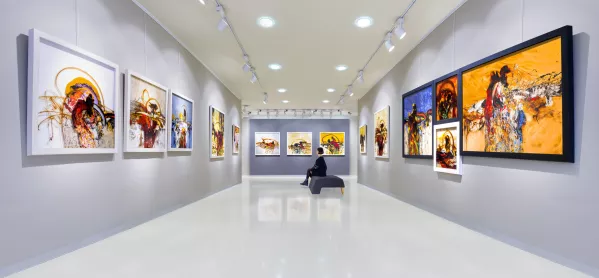What I want for my learners? It’s in the art around us

In the reception of my college, there’s a large piece of student art hung on the wall, obvious to all who come in and visible through the glass facade of the building to any who might glance its way. It’s a large 3D word made out of cardboard. It’s the single word “igniparous”. Like most good art, it raises questions. The first is usually what the word means. I looked it up for you. It is an adjective to describe something that catches fire. Like flammable. Or inflammable. Whatever.
It raises another question: what is it that is igniparous? Is it the thing itself, being made out of cardboard, or is it something else, the place where it is hung, perhaps? And can a single word be a piece of art? It’s a talking point. Igniparous. I like seeing that word as I enter the college. I like the questions it raises in me. Because I think it is a good word for an educational establishment. Not that I am some kind of pyromaniac, but I believe education is about being igniparous. It is about sharing knowledge, seeing the firelight in a student’s eyes and then seeing it catch through their life as its flame illuminates their way and helps them to trace a way ahead through the dark.
Teaching in FE: How education has changed - looking back after 34 years
Background: College student exhibition documents lockdown life
Classroom practice: Five-minute lesson tasks to keep in your back pocket
There’s a second piece of art near the college, too. This stands opposite the entranceway, on an old triangle of pavement between two roads and a rail track which is bypassed by all. This is a statue of a man standing on one leg and leaning forward, hands out straight ahead of him and the second leg raised so his whole body forms a T shape. Down the side of the plinth are the words “Man Can’t Fly”. It is as if he is aimed at the college like a rocket.
It was there before the college was built and was intended by the artist to remind people to keep their feet on the ground, to not lose touch with the important things by allowing ambition to blind them. But it seems instead to be a dampener on ambition, as if it is telling people not to even try. And in this post-industrial city, where lots of people feel beaten down by the circumstances of their lives, that is not a message that people really need to hear or a lesson they need to learn. I struggle with that statue and the message it is giving to our students, if they pay any attention to it at all.
Stepping off the plinth
And around the corner, there is a third piece of art, a statue of the local Stoke notable, Josiah Wedgwood. It faces the entrance to the city’s railway station and is the first thing to welcome them as they come to Stoke. There he stands in his 18th-century frockcoat and wig, a ceramic pot in his hand. He is focused on this pot as he is stepping forward, the toe of his right boot coming over the edge of the plinth. I like this statue. It represents a deep civic pride in this city and teaches an important lesson to our students, should they care to see it and learn. After a bout of smallpox at the age of 38, Josiah Wedgwood had to have his right leg amputated.
The leg with which he is stepping into the world in the statue was missing from him in real life. Without his right foot, he couldn’t operate the potter’s wheel alone without help. He needed someone else to power the pedal that spun the wheel that made the pot that went out into the world and gave this city wealth and pride and prestige. There is a lesson here about community, about resilience, about dedication to one’s art and its ability to transcend the limitations we have. I want my students to learn this lesson.
And so I put these three together: the word igniparous, the statue of the man who can’t fly and the figure of Wedgwood stepping boldly off his plinth. I want my students to be set alight by the knowledge and the skills they will acquire in our college. I want them to keep one foot on the ground, but I do want them to aspire, to try to fly. And I also want them to know the power of cooperation, the strength there is in community, and the pride in production that will allow them to forge a place for themselves in this world. Maybe one day I should take a class on tour to explore these three works of art and discuss with them what they say. In the meantime, I will stay in my classroom and teach, and together we will explore the world and dream of one day setting it alight.
David Murray is an English teacher at City of Stoke-on-Trent Sixth Form College
You need a Tes subscription to read this article
Subscribe now to read this article and get other subscriber-only content:
- Unlimited access to all Tes magazine content
- Exclusive subscriber-only stories
- Award-winning email newsletters
Already a subscriber? Log in
You need a subscription to read this article
Subscribe now to read this article and get other subscriber-only content, including:
- Unlimited access to all Tes magazine content
- Exclusive subscriber-only stories
- Award-winning email newsletters